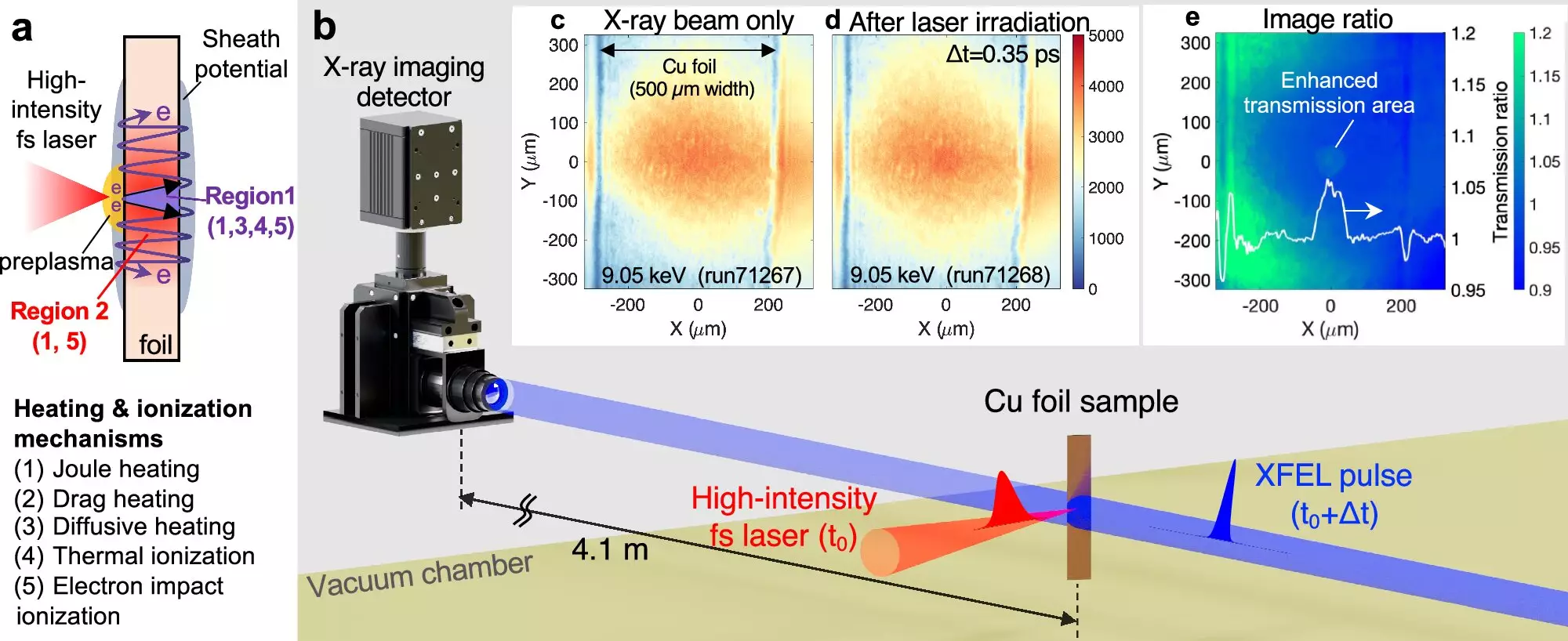In an extraordinary turn of events, physicists have made significant strides in understanding the transition of copper from a solid state to a plasma state, characterized as warm dense matter. Using ultrafast laser technology, researchers were able to study the heating and cooling processes that occur over a fraction of a second—specifically in just a few picoseconds, which is a trillionth of a second. Under the extreme conditions induced by high-powered laser pulses, copper’s temperature can soar to nearly 200,000 degrees Fahrenheit, momentarily transforming it into a dense plasma before it violently vaporizes. This fascinating conversion not only illuminates the behavior of materials under extreme conditions but may also provide valuable insights into phenomena occurring in the cores of giant planets and the mechanics responsible for fusion energy.
The research, spearheaded by Hiroshi Sawada and his team from the University of Nevada, Reno, utilizes a sophisticated method called pump-probe experimentation. Initially, a powerful laser pulse—designed to rapidly heat the copper—is fired at the sample (the pump). This is immediately followed by an ultrashort X-ray pulse from the X-ray Free Electron Laser (XFEL) at Japan’s SPring-8 facility, capturing the state of the copper as it undergoes this transformative process (the probe). The combination of these two techniques allows researchers to observe temperature fluctuations and the ionization states within the copper, granting a clearer picture of plasma formation under laser stimulation.
Previously, due to the rapid pace at which these changes occur, data collection was severely limited. This groundbreaking approach has changed that reality, enabling scientists to track the temperature evolution in the material with a resolution significant enough to understand heat propagation on a micron scale.
In their recent findings, as published in Nature Communications, the researchers made numerous surprising discoveries that contradicted initial simulations. Contrary to their expectations, they found that the copper did not transition into what is conventionally understood as plasma but rather achieved a warm dense matter state. The team was astounded by these results, illustrating the robustness and dynamism of experimental physics. Each laser pulse inevitably destroyed the targeted copper strip, a challenge that the team overcame by carefully preparing the samples with intricate precision, facilitating 200 to 300 individual assessments during the experiment.
This innovative use of XFELs positions this research as one of the most comprehensive analyses of material behavior at extreme temperatures recorded to date—an advancement that holds implications across various disciplines including chemistry, astrophysics, and materials science.
The ramifications of this research extend well beyond the laboratory. With plans to apply this advanced method across other fields, Sawada envisions enhancements in plasma physics and studies involving high-energy-density science. Facilities equipped with free electron lasers, such as the next-generation MEC-U facility at SLAC and the upcoming NSF OPAL laser at the University of Rochester, are poised to utilize these findings to investigate different materials’ responses to high-intensity lasers. Understanding how heat transfers through dense forms of matter can unveil new pathways for research into inertial confinement fusion as well as the properties of materials under extreme conditions, a topic with significant implications in both theoretical and applied physics.
Despite the promising results, the journey toward fully understanding warm dense matter remains fraught with challenges. Diagnosing warm dense states requires increasingly precise technological methods and comprehensive verification processes. The complex interplay between energy input and material response needs meticulous examination, particularly as science continues to explore higher thresholds of intensity in laser applications. Sawada is hopeful that future studies can expand upon these findings, tackling the nuanced aspects of heat propagation and enriching our grasp of material behavior under extreme conditions.
As researchers continue to unveil the intricacies of warm dense matter, this critical exploration not only reshapes our understanding of fundamental physics but also opens the door to innovative applications that could benefit various scientific endeavors, from laser-driven fusion energy to the study of planetary interiors. By delving deeper into these high-energy phenomena, we inch closer to unlocking the mysteries that govern the universe’s most fundamental materials.


Leave a Reply